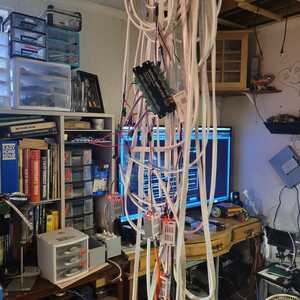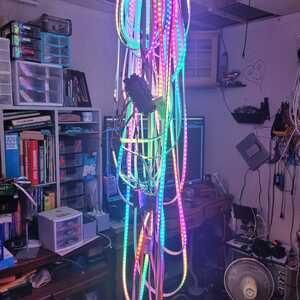Hi folks,
Theories suggested above of colliding electrons etc. for DC power lines emanating from a single source are rubbish!
The picture above from @robotbuilder correctly illustrates the principle, albeit with 'conventional current', instead of 'electron current' flow direction.
However, that does not mean two batteries is a smart idea ... If they are were identical in actual voltage output etc., then it would probably work, but if one becomes discharged first, the other one could end up charging it .. this is a situation that can be dangerous, particularly, but not limited to, in the case of lithium batteries.
There should only be one supply source.
-----------------
Note, the absence of 'colliding electrons' point only applies to a system supplied with a constant DC power source (or AC whose frequency is low compared to the propagation time around the loop, as occurs with 50/60 Hz within a small building). Lines carrying high frequency waves (or pulses), such as an Ethernet cable, are (data) transmission lines, and having waves coming in different directions would collide. But that is a different story for another day.
---------------
The problem with LED strips (that are beyond a short length), is that the wire is rather thin, has substantial resistance per unit length, and the LEDs demand a substantial current. Hence, as the length gets longer the voltage drop gets larger and the LEDs dimmer...
Connecting both ends helps as it effectively halves the current flow through the LED wiring and hence substantially reduces the voltage drop.
There is a good case for extra connection points strategically placed along the strip, if your LED strip is so long that the middle LEDs are still suffering from excessive voltage drop, in spite of connecting at both ends. Of course, the means of physically making the connection might be a challenge.
You may be interested to know that a major proportion of domestic house mains power in the UK is wired this way from the Consumer Unit (colloquially often still called the "fuse box", although most now have circuit breakers) to the power sockets, as so called 'ring mains' wiring. That is, from each circuit breaker, two pairs of each of three wires head out from the consumer unit in opposite physical directions and eventually meet up, after each 'visiting' several wall sockets to form a ring circuit. This way, wires, that when used singularly would be rated at a bit over 20A, can be supplied from a 30/32A breaker.
(Some other circuits, usually those serving an individual load, such as an immersion heater, use a single radial wiring topology.)
Best wishes all, Dave
There should only be one supply source.
Indeed. Unfortunately I can't go back and edit that post!!
So it was an issue of resistance along the bus line.
Thanks for the extra info.
Hi @robotbuilder,
I recall reading in the past that voltage drop can be a problem with these devices, which is completely logical given the current draw of a large number of LEDs in parallel, thin wires and a low voltage supply, so that even a fraction of a volt drop will have an effect.
I am not clear anyone was actually thinking about using two batteries ... but as it was mentioned, I just wanted to ward anyone from thinking it was a good idea.
Best wishes, Dave
Yes, You Can. If you should is another question.
Have any seen the Explosion from the Veritasium Video "How Electricity Works" and the Reponses came Hard and Fast, Including ElectroBoom, EEVBlog and Others. Finally, Vertasium made a Reply Video to correct the misunderstandings
If you WANT to know how Electricity really works, these videos will make it more Clear
Electrical Engineers understand these principals and how to apply them in the real world.
EEvBlog Repsonse. A Professional Electrician
Basically Electricity 'runs' though wires via Pulse of Energy (not flowing Electrons). As stated in the Videos, Electrons may 'move' but they don't not Flow - there is no Water example here, the water comparison is out the window, it is a Teaching Tool.
This One, a long time I have I watched. All this life has he looked away to future, to the horizon. Never his Mind on where he was! what he was doing!
Yoda
Theories suggested above of colliding electrons etc. for DC power lines emanating from a single source are rubbish!
There are no Colliding 'Electrons' in an AC circuit either
The Only Colliding Electrons I know about are in Particle Accelerators
This One, a long time I have I watched. All this life has he looked away to future, to the horizon. Never his Mind on where he was! what he was doing!
Yoda
There should only be one supply source.
You can design Electronics that take in Multiple power sources at the same time, this happens with Smart Homes (Solar/Wind and Mains Powered)
One Power source makes projects simpler
If the Poster wants to Use 2 Sources, they could use an appropriate Diode on Both ends.
This One, a long time I have I watched. All this life has he looked away to future, to the horizon. Never his Mind on where he was! what he was doing!
Yoda
You Can. If you should is another question.
Which is as I understood it to be. I am aware of methods for using more than one power supply.
I did emphasis that the water flowing was an analogy. I have seen the video you referenced as well.
Complicated models aren't useful for electronic enthusiasts, who are not electrical engineers or physicists, starting out in their quest to build electronic circuits.
There are also simple analogies to help a beginner visualize the behaviour of capacitors, inductors and transformers in ac circuits.
Hi @Dazza,
Thank you, but I believe I am aware of how electricity flows .. and a DC current does amount to a flow of electrons ... (if it doesn't perhaps you could explain how a battery or electrolysis works without the flow) ...the confusion arises because the rate of flow is totally different from the transmission speed of an pulse or a wave.
When we discuss speed, we often think of a solid object, say a car or a ball. In this case, the speed refers to the object as a whole ... if the car travels at 30mph in a straight line, then after 2 minutes, it will be 1 mile away from its starting point. If a tsunami wave travels at 30mph, that does not mean a 'labelled' water molecule in the path of that wave would similarly travel 1 mile in two minutes.
When you discuss waves (or pulses, which are effectively a 'short burst of wave',) then you are referring to energy in some way perturbing whatever is in its vicinity. Such waves can move much faster than the bulk of the material that is being perturbed.
This has led to some commentators, misunderstanding the situation, and mixing fact with fiction to produce semi-plausible explanations.
----------
Taking the electron to be a particle, (rather than a wave, bearing in mind the duality implied by quantum physics), electrons in a solid are continually 'colliding' ... the only difference between that and the particle accelerator case is the energy of that the electrons have.
Consider the difference between 'bumper/dodgem cars at a fairground and driving mayhem in an action movie with multiple car write offs in every direction. Then refine the analogy to imagine the bumper cars have 'perfect' bumpers so that all of the energy of each collision is preserved, the collision just resulting in a redistribution of that energy betwen the participants. In the particle accelerator case, the energy is such that the bumpers can not handle an impact of that force and hence no longer be 'perfect'.
----------
That is, if you measure the time it takes a pulse to travel along a pair of wires (e.g. coax cable or twisted pair), it will typically be of the order of 70% of the speed of light in a vacuum ... say 8" or 20cm per nanosecond. (It depends a bit on wire construction; these figures are just to give a feel.)
However, transmission of a wave or a pulse refers to the electrons effectively nudging their neighbour. (Maybe, think of large crowd jostling to pass through a narrow gate to get into a football match, that is due to start in a couple of minutes time.) There is a total net flow but the total number of available electrons to move is many orders greater than the number of electrons you would estimate flowing past a point, knowing the current and the charge of an electron. On this basis, depending on conditions, you might conclude the 'bulk' flow rate of electricity is comparable to the speed of a snail! But note, for the DC case, there is still a net flow!
Similar phenomena may be seen with water ... e.g. when a tsunami is caused by an earthquake, the resulting wave can travel quickly - https://www.noaa.gov/education/resource-collections/ocean-coasts/tsunamis - mentions 500 mph in deep ocean and 30-40mph in shallow coastal water. That does not mean the entire volume of water physically above the moving earth surface travels at this speeds as a 'solid' object, at these speeds, but rather the wave of energy is moving at these speeds. There will be a net flow of water ... as experienced by the flooding of any low lying land in its path, but this will not (necessarily) be the same water molecules that were initially pushed by an earth movement.
-----------------------------------------------------------------------
Similarly, yes of course it is nearly always possible to come up with a more complex solution, but anyone providing advice has to think of the consequences, especially regarding safety, taking into account the recipient is probably not an expert in electronics, etc.
e.g. I pointed out using two batteries was inadvisable because of the danger of cross charging.
I knew precautions could be taken to mitigate the risk, but is it a responsible approach when it is far from essential to the overall project? (And in this case, I wasn't convinced it was even being seriously contemplated, merely that it had been mentioned, possibly by accident.)
---------
Comparable situations happen in the professional world, but if it is a safety critical situation, a huge amount of time, effort and materials will be expended ensuring that not only that the primary risk is mitigated, but also further precautions, assuming the primary mitigation may also fail to meet its obligations. Mitigations of this type tend to be particularly difficult, as often the failure wil only be discovered when they fail to protect. For a non-electronic example, consider a non-refillable fire extinguisher with a jammed valve. Many electronic examples are equally perplexing.
Occasionally, 'short cuts' or 'oversights' mean this high level of diligence does not occur and the result can be catastrophic.
So, yes it is possible to use a diode in each feed .. but then there is a danger the diode will fail or maybe the person will make a wiring mistake and accidentally short it out (a significent percentage of problems on this forum are due to wiring errors, in spite of the person concerned doing their best to check the wiring many times). Will the person be regularly checking the diodes have not developed a short circuit ... I don't think so?
So how can anyone advising be confident that such precautions are actually in place and effective?
Sorry, but in that situation I will consider advising what I believe to be the safer option or refrain from not helping at all.
----------
To sum up, when answering a question, I sometimes consider providing an even more lengthier answer, but surely my sermons are long enough without referring to Maxwell equations or quantum theory when discussing how best to power an LED? 🙄
Best wishes all my friends .. and above all stay safe ... Dave
It's crazy busy for me right now, but I wanted to drop by and say thank you very much for the pictures, analogies, and deeper discussions. It has been immensely helpful to my understanding of how these can be powered from both sides.
I am actually not doing that, rather splitting them up in shorter chunks, but I was wondering how it worked 😊
PS: How do I get out of this editor on my phone? 😅
Interested in learning about electrical engineering!
I think it is possible to over explain to someone learning new concepts. How would you explain what an atom is? Dive deep into probability clouds and quantum mechanics? I might say an ideal diode is a one valve like a tyre valve. Air flows one way but not the other. Real diodes are a bit more complicated than that but it is a good start. The same with the transistor or mosfet and other solid state devices.
I learned from this guy. https://www.thesmarthomehookup.com/the-right-way-to-join-led-strips-and-do-power-injection/
At this time I have 100m of LEDs with a signal amplifier, and a 5v 2a power supply every 10m. I've been torture testing in my shop, and nothing gets even kinda warm.
I do need a more heavy duty power supply as the lights still go dim, or freak out (flash, dim) from not enough juice.
@lon I have read a bit about this type of hookup but I guess I got lucky when I ordered my LED strips, all power comes in from one end and is supplied by standard USB wall wart.
First computer 1959. Retired from my own computer company 2004.
Hardware - Expert in 1401, and 360, fairly knowledge in PC plus numerous MPU's and MCU's
Major Languages - Machine language, 360 Macro Assembler, Intel Assembler, PL/I and PL1, Pascal, Basic, C plus numerous job control and scripting languages.
Sure you can learn to be a programmer, it will take the same amount of time for me to learn to be a Doctor.



